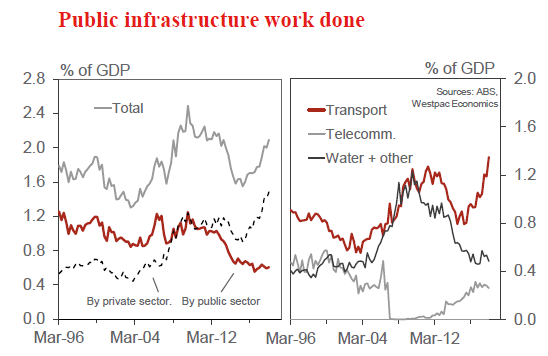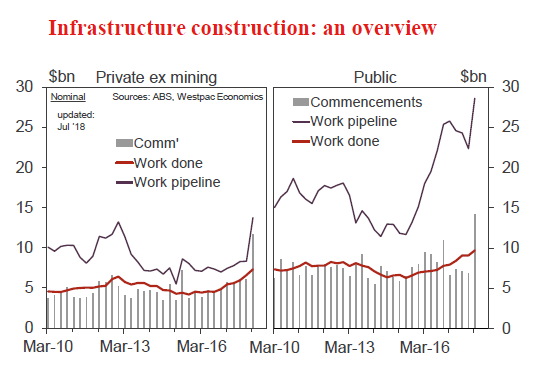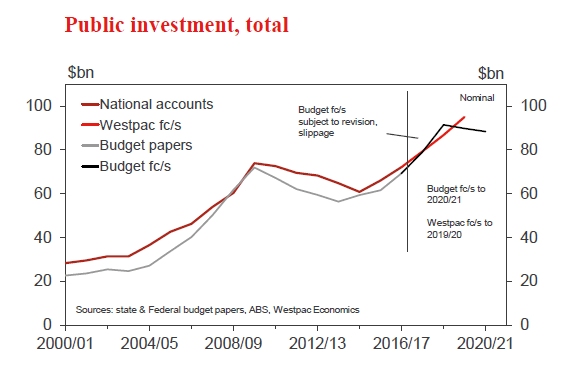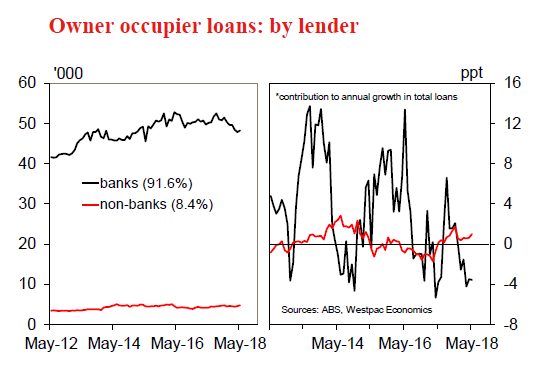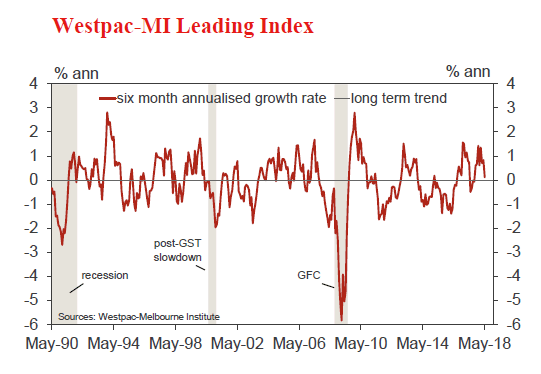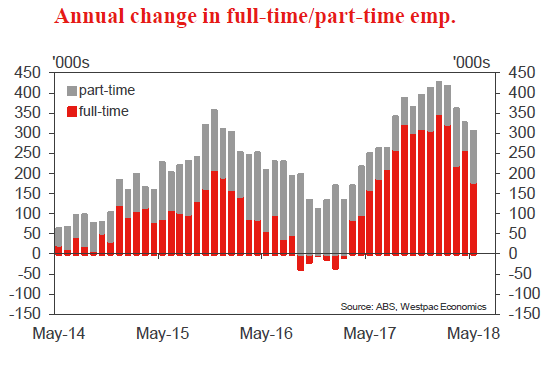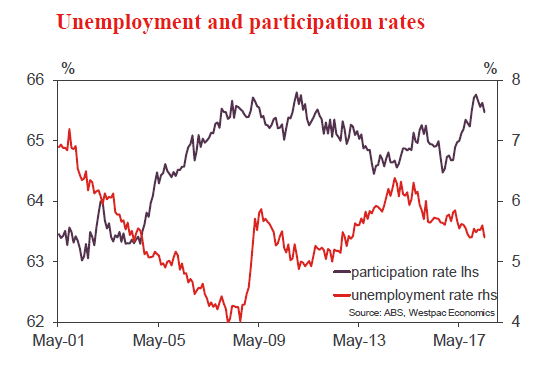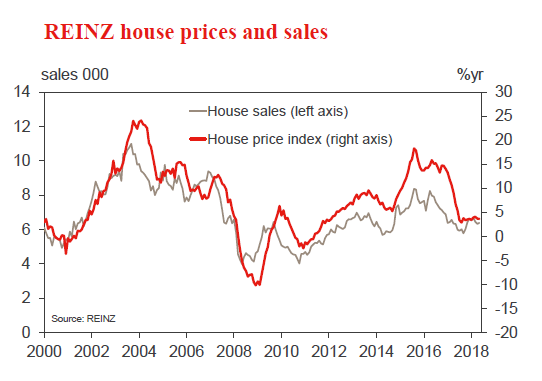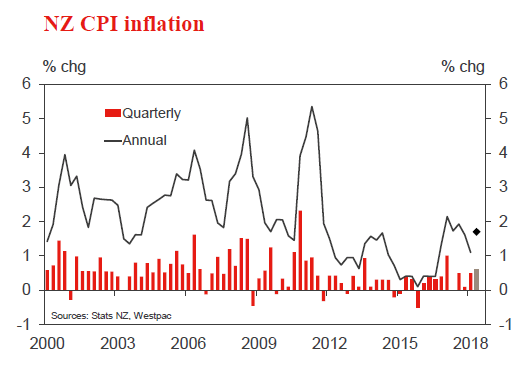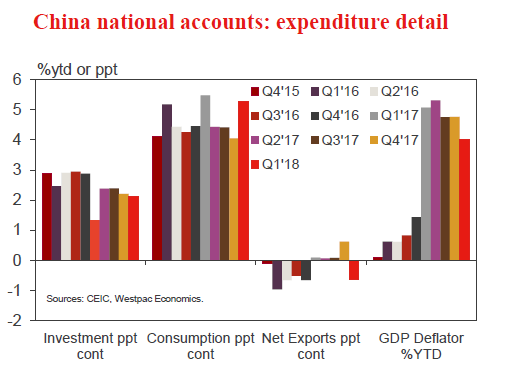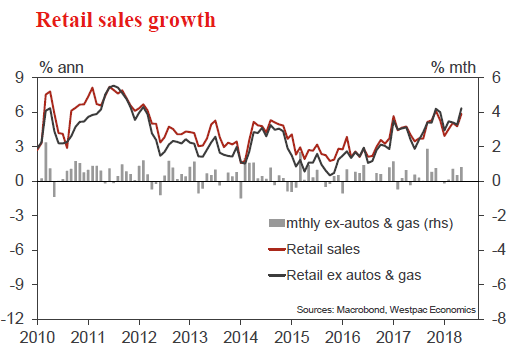Week beginning 16 July 2018
- Non-mining infrastructure upswing has considerable further upside.
- Australia: Westpac-MI Leading Index, RBA minutes, employment.
- NZ: CPI, REINZ house sales & prices.
- China: GDP.
- US: Fed Chair Powell’s semi-annual testimony to congress, retail sales.
- Key economic & financial forecasts.
Information contained in this report current as at 13 July 2018.
Non-Mining Infrastructure Upswing Has Considerable Further Upside …
The non-mining infrastructure construction sector is a key growth driver of the Australian economy. This includes projects in both the public and private sectors. Here we gauge the current momentum in activity and assess prospects for 2018 and 2019.
This is a timely update with the round of annual state budgets now complete (with the exception of South Australia, where the budget was delayed due to the recent state election).
Hereafter reference is to non-mining infrastructure, unless stated otherwise.
The backdrop is that Australia is playing catch-up, investing in much needed infrastructure, particularly in the capital cities. This follows an extended period of under investment, in part crowded out by the mining boom and then delayed post the GFC as governments for a time focused on fiscal repair and showed a lack of appetite for additional borrowings to fund such spending. More recently, the states have made greater use of their existing balance sheets to assist with funding of projects.
The pressing need for additional infrastructure has been compounded by rapid population growth, with increases well in excess of expectations – creating growing pains in our two largest capital cities of Sydney and Melbourne.
Infrastructure activity undertaken in the March quarter was valued at $16.5bn, directly representing 3.8% of the economy. To place this in context, infrastructure eclipses new home building activity, which was $16.2bn in March and the gap is set to widen.
Infrastructure: a roller-coaster ride since 2012
The five year period from 2012 was a roller-coaster ride for the infrastructure sector. Activity weakened from the end of 2012 through to mid-2015, with a peak-to-trough decline of almost one-third. Subsequently, infrastructure activity rebounded sharply. Work surged by 23% over the year to March 2018 and is now 54% above the low of mid-2015, to be 6% above the earlier peak.
These large swings in activity materially impacted overall economic growth. The infrastructure drag at its largest was a subtraction of 0.6ppts from annual GDP growth in mid-2014. The sharp turnaround has seen infrastructure activity directly add 0.75ppts to GDP growth over the past year. That is, the sector (which is a little less than 4% of the economy) directly accounted for 25% of all economic growth over the past year.
By way of historical experience, with the exception of a shortlived spike in 2008, ahead of the GFC impact, this is by far the largest direct boost to activity from infrastructure activity (see chart opposite). Earlier peak contributions are in the order of 0.4-0.5ppts, such as in 2004, 2005 and 2012.
Infrastructure investment spans a number of segments. Typically, projects are focused on transport, telecommunications, electricity generation, as well as water & sewerage. There are spill-over effects from the public sector to private non-mining investment, most clearly with some projects undertaken as PPPs, Public Private Partnerships.
Over the past year, the upswing in infrastructure activity has been concentrated in transport projects (accounting for 56% of the total increase, the bulk of which are public works) and electricity (responsible for 30% of the rise, largely in the private sector), while water and sewerage accounted for 10% of the lift.
At the start of this year, public transport infrastructure projects under construction (or at the committed stage) were valued at $112bn, as reported by the Deloitte Access Economics Investment Monitor. This is up from $56bn two years earlier.
This boost to public transport investment is centred, but not confined to, NSW and Victoria, which together account for 73% of projects under construction, well in excess of their share of national output and national population, both around 58%.
Infrastructure activity: sharp upswing to continue
With infrastructure activity having rebounded over the past two years to currently be a little above the previous peak of 2012, the question is where to next, a consolidation at these high levels or is the prospect for further strong growth? Indications are that there is considerable further upside to investment spending and that growth is set to be brisk.
The pipeline of work outstanding on infrastructure projects currently under construction is actually expanding not shrinking as construction work fails to keep pace with the commencement of new projects. In the March quarter, the pipeline of work yet to be done jumped to $42bn, up from $33bn at the start of 2017 and from $22bn at the end of 2015. Recently, in Victoria work has commenced on the $10.9bn Melbourne Metro rail project and the $6.7bn West Gate Tunnel Project. Both are PPP’s, suggesting some of the work may be recorded by the ABS as undertaken by the private sector.
Turning to the state budgets, we find that they reveal that the states intend to ramp-up investment in 2018/19, with a focus on infrastructure, as well as investment in non-residential building and equipment spending.
Aggregating the annual state budgets, as well as including the Federal budget, indicates that public investment grew by 12.5% in the 2016/17 financial year, followed by an estimated 14% increase in 2017/18, and is forecast to accelerate to a near 16% expansion in 2018/19.
A word of caution, in 2017/18 work failed to meet budget forecasts, with considerable slippage, largely in NSW. By way of comparison, a year ago, the budget papers predicted investment would increase by 22% in 2017/18 and rise by 6% in 2018/19. At the time, we assessed that the 2017/18 forecast was ambitious, and discounted it somewhat. While some ongoing slippage is inevitable, given the scale of the transport projects underway, we note that the forecast for 2018/19 is less ambitious.
Relative to a year ago, construction work in NSW has been pushed back. In addition, new projects have received the final go ahead, boosting investment plans in Victoria for 2018/19 and 2019/20, and boosting plans in NSW for 2019/20 and 2020/21 (over and above slippage).
This leads us to a discussion of the Federal Budget forecasts for overall public demand, which as well as including public investment, covers spending on health and other consumption goods and services. Note that public demand directly accounts for almost 25% of the Australian economy. Public demand having increased by 4.5% in 2015/16, 5.0% in 2016/17 and an estimated 5.0% in 2017/18 is forecast in the Federal Budget to increase by a more modest 3.0% in 2018/19 and by 2.75% in 2019/20. The ongoing strength of the investment upswing suggests that the Federal Budget forecasts for public demand will be exceeded, potentially comfortably so.
As highlighted previously, incorporated in our overall growth view for Australia (GDP growth of 2.7% this year and 2.5% for next year) is an upbeat expectation for non-residential construction activity, led by the public sector. We expect public demand growth of 4.5% for 2018/19 and 3.5% for 2019/20.
Investment pipeline to be boosted by additional projects
The state budget papers understate the outlook for public investment. Notably and understandably, funding for projects that are still at the ‘under consideration’ stage are not included in the budget figures – even though there may be a clear and publicly stated intention to proceed in the near term.
In the case of Victoria, the Melbourne Metro rail project and the West Gate Tunnel project are included in the budget forward estimates. However, two notable projects not included in the forward estimates are the $16.5bn North-East Link project and the Melbourne Airport train link, for which the Commonwealth Government has provided $5bn in funding, subject to a matching grant from Victoria. The state government is committed to the North East Link project and expects the tender process to commence in the next term of government (the upcoming state election is on November 24 this year).
Similarly, in NSW, the budget forward estimates do not fully include a number of multi-billion dollar transport projects which are under active consideration by the current government. The NSW state election is to be held of March 23 2019.
The pipeline of public transport projects currently under consideration is estimated by Access Economics to be $60bn, of which 70% are in NSW and Victoria.
To finish, we turn to private sector investment in electricity generation. Work on such projects, where the focus is on investment in renewable energy (wind-farms, solar and battery storage), accounted for a sizeable 30% of the increase in total infrastructure activity over the past year. Here as well the outlook is positive. The value of work yet to be done on projects currently under construction is expanding not shrinking, up 67% on a year ago. Moreover, there is a sizeable pipeline of projects under consideration, estimated in the Investment Monitor to be $10bn, in addition to $1.5bn of projects already at the committed stage, together exceeding the value of projects currently under construction, at $8.3bn.
In summary, activity in the non-mining infrastructure construction sector is increasing at a brisk pace. To date, the lift in work represented a rebound, reversing the sharp pull-back from late 2012 to mid-2015. Going forward, indications are that there is considerable further upside to investment spending and that growth is set to remain brisk. The backdrop is that Australia is playing catch-up, investing in much needed infrastructure, particularly in the capital cities, a pressing need compounded by rapid population growth, with increases well in excess of expectations. Over the past two years, governments have added major transport projects to the investment pipeline and with other projects under active consideration the pipeline is set to expand further as we move into 2019 and beyond.
The week that was
Apart from yet another escalation of global trade tensions, it has been a positive week for our economy, with consumers showing greater optimism over the outlook and business conditions remaining well above average.
The Westpac-Melbourne Institute consumer sentiment survey was the key release of the week, highlighting growing optimism amongst consumers towards the economic outlook. This was true of both the one and five year view, with each index around 12 points above the five-year average. Despite this growing optimism over the economy, households remain much more circumspect regarding their family finances. This imbalance between economic and family finance assessments continues to be driven by weak wage growth and high levels of household debt. The limited buffer that many indebted households have against their mortgage amplifies this tension. A clear positive in the mix however is the passing of the Government’s multiyear tax package: middle-income households’ sharp jump in sentiment this month is a vote of confidence in support of the tax cut’s effect. Towards consumption and housing, views on the household family budget dominate. While our time to buy a major household item series has risen to be near the top of the range of the last two years, it remains below average overall and well below levels consistent with buoyant consumer spending. Highlighting continued affordability pressures, the time to buy a dwelling series is well below its long run average, despite house price growth having dissipated. Price expectations look to be holding consumer demand for housing back as well, with more than half of all consumers expecting prices to be unchanged or lower in twelve months’ time.
It is important to note that the July survey was completed before President Trump formally announced a 10% tariff on another $200bn of Chinese imports to the US – an escalation previously mooted when the last round of tariffs came into effect. Being levied on four times more imports than his previous round of tariffs, it is not surprising that markets have been unnerved, particularly in Asia. For Australia, the risk in this burgeoning trade war is not so much the initial shock to trade, which is likely to be small, but rather the flow-on consequences for wealth and investment. Via financial markets, wealth will take the first hit. Come 2019 however, if tensions are sustained or escalate further, there could also be a negative headwind for business investment and employment, both here and across the world. As we look ahead then, consumer and business sentiment will be an important barometer of the potential economy-wide shock to Australia from these trade frictions.
On business conditions and confidence, the June NAB business survey reports that both remain strong despite easing in recent months. Business confidence is currently in line with its long-run average; while conditions are well above. Within the condition detail: trading is holding near its recent highs and profitability is robust; but the employment index has continued to trend lower. On the latter however, this barometer of jobs growth still suggest that near-term gains in employment will be more than sufficient to hold the unemployment rate at its current level, assuming stable participation. Assessing the growth pulse by sector: the NAB survey indicates momentum has eased back in the construction sector as it strengthened in business services. Against these two areas of strength, persistent consumer sector weakness is a stark contrast.
Taking a step back from the current run of data, a research bulletin on the profile of owner-occupier interest only borrowers was released this week. The HILDA data to 2016 that this research is based on highlights that: owner-occupier interest only loans are spread fairly evenly across the major capital cities; and that the quality of these loans improved between 2014 and 2016 as lending conditions were tightened. Interestingly, those with interest only loans tend to have higher incomes and are more likely to be self-employed or on fixed term contracts. Though it pre-dates the latest round of APRA’s macro-prudential policy tightening, this data acts as a very useful starting point for developing an understanding of the evolving state of housing finance in Australia.
Finally to the US, where the June employment report and CPI collectively highlighted the financially constrained state of the US consumer. The primary restraint for consumption evident in the data is an absence of real wage gains. In the June quarter, annual real hourly earnings growth came in at just 0.1%yr. As hours worked are also unchanged over the period (indeed since 2014), the established worker is yet to see a meaningful benefit from the post-GFC recovery. Technology and globalisation are at play here; however, the domestic supply of labour still returning to work 10 years after the GFC is arguably the major impediment to accelerating wage inflation. Employers won’t be forced to boost pay and conditions to attract workers for a while yet, with at least another year of strong employment growth necessary to erode remaining slack.
Chart of the week: Housing finance
Australian housing finance approvals were firmer than expected in May, the number of owner occupier loans rising 1.1% vs an expected 2% decline, and the value of investor loans up 0.1%.
The lender detail shows a strong 4.5%mth gain for non bank lenders, up 12.9%yr. However the number of bank loans, which accounts for over 90% of finance approvals, still posted a 0.8% gain – the implied net shift in market share still looks minor, worth about 1ppt over the last year.
Overall, the May finance data is a little at odds with other housing market data that suggests conditions have weakened further through May-June, auction markets in particular. That was thought to be in response to tighter lending criteria. Again though, the May finance detail suggests little incremental change in lending conditions. Hopefully the next few months will clarify the situation. Until then we suspect the finance data is the ‘odd one out’.
New Zealand: week ahead & data wrap
A game of two halves
Caution among consumers has played an important part in the economy’s loss of momentum this year. While we expect growth to remain subdued, there’s reason to think that households’ fortunes will look a bit better in the second half this year than they did in the first. The inflation picture for New Zealand could also look somewhat different by year-end.
While consumer spending has seen some moderate gains in recent months, the trend has clearly softened over the first half of 2018. The latest credit and debit card figures showed a 0.8% increase in retail spending in June, which was a little stronger than forecast. But comparing the three months to June with the preceding three months, spending levels have essentially been flat.
Last week we noted that financial markets have been slow to recognise the cooling in the New Zealand economy this year. In contrast, we’ve been flagging the likelihood of a first-half slowdown for some time. In particular, the softness in consumer spending is in line with the slowdown that we’ve seen in the housing market, as a range of new Government policies have weighed on house prices and sales.
We’ve also been pointing out that things could look different again by next year, as increased fiscal stimulus starts to fill in some of the gaps left by a more subdued private sector. For households, that turning point may have already arrived. From 1 July the Government’s Families Package came into full force. The package includes winter energy payments for the elderly and those on benefits, a tax credit for newborns, and increases in Working for Families payments. That’s on top of an increase in the accommodation supplement that came into effect in April.
All together, this amounts to more than a billion dollars a year going into people’s pockets. And importantly, it’s targeted towards lower-income households who are more likely spend than save it.
That said, households will still face some headwinds over the second half of this year. One is that the housing market is likely to remain soft as the Government continues with its measures to dampen housing speculation. Restrictions on foreign buyers of property are expected to come into force sometime next month. Then from early next year, the use of negative gearing by property investors will start to be phased out. These measures will weigh on property values, and as a result are likely to weigh on people’s willingness to spend as well.
Another issue is the cost of fuel. The rise in world oil prices and a weaker New Zealand dollar meant that petrol prices had already risen to new highs by early June. The Auckland regional fuel tax (from July) and a national increase in excise duty (expected to be from September) will add further to the cost of filling up over the second half of the year. Higher fuel prices tend to detract from spending in other areas.
On balance, though, we think that households will fare a little better over the second half of this year than they did in the first half. We’ll be watching for signs of a pickup in spending growth over the coming months.
Looking ahead to next week, the highlight is likely to be the June quarter CPI on Tuesday. We expect a 0.6% rise for the quarter, which would see the annual inflation rate rise from 1.1% to 1.7%. Fuel and food prices are likely to make the biggest positive contributions. We also expect that the lower New Zealand dollar over the last year will put some upward pressure on the retail prices of imported goods.
Perhaps more importantly, we expect these same factors to push inflation just above 2% by the end of this year – putting it in the upper half of the Reserve Bank’s target range for only the second time in seven years. In contrast, the Reserve Bank’s forecasts in its May Monetary Policy Statement saw inflation remaining below 2% until the end of 2020.
We don’t think that the rise in inflation this year will necessarily be sustained. Domestic inflation pressures are growing as the economy uses up its spare capacity, but this tends to be a gradual process. In the meantime, the tradables portion of the CPI is still driving most of the variation in the inflation rate. That means that maintaining inflation around 2% next year would require a further surge in world oil prices and/or an ongoing slide in the exchange rate.
Data Previews
Aus Jun Westpac–MI Leading Index
- Jul 18, Last: 0.11%
The six month annualised growth rate in the Leading Index dropped from +0.83% in April to +0.11% in May. This was the weakest read since September last year with a clear shift lower in the first half of 2018, albeit with the index growth rate still pointing to momentum running slightly above trend.
The June reading will include a mixed bag of component updates. On the positive side: the ASX200 is up 3.0% vs 0.5% last month; the Westpac-MI Consumer Expectations Index, rose 5.1% vs a 1% fall last month; and the Westpac-MI Unemployment Expectations Index improved slightly. On the downside: commodity prices slipped 0.6% (in AUD terms) vs +0.6% last month; dwelling approvals were down 3.2% vs a 5% fall last month; and the yield spread narrowed 20bps, partly reflecting rising short term rates.
Aus Jun Labour Force – total employment ‘000
- July 19, Last 12k, WBC f/c: 17k
- Mkt f/c: 16.5k, Range: 5k to 30k
Australian employment rose 12.0k in May undershooting both the market (+19k) and Westpac’s (+17k) forecasts. Fulltime employment fell 20.6k while part-time employment rose 32.6k. Overall this can be taken as a soft update with total hours worked falling 1.4% in the month. But it should be noted that hours worked are very volatile month-tomonth and they rose 1.2% in April.
Our forecast for June is a 17k increase in employment. This is broadly in line with results over the last two months and around the middle of the 2018 ytd average of 12.4k and the year to May 2018 average of 25.3k.
A factor that may affect June employment was the 31 May Fair Work Commission announcement of a 3.5% increase in the minimum wage, but note last year’s increase of a similar scale was followed by still robust job gains. Seasonal effects are small for June employment change with June’s seasonal factor for total employment slightly smaller than May’s.
Aus Jun Labour Force – unemployment rate %
- July 19, Last 5.4%, WBC f/c: 5.4%
- Mkt f/c: 5.4%, Range: 5.4% to 5.6%
Despite the moderate increase in employment in May, the unemployment rate dipped to 5.4% from 5.6%, a significant drop in one month (5.40% from 5.60% at two decimal places).
Driving the change in unemployment was a 14.8k decline in the labour force with the participation rate falling to 65.47% from 65.62% which was not too far off the recent high of 65.75%.
Changes in the participation rate have tended to closely follow changes in employment. Participation rose during the employment upswing in the second half of 2017, and consequently moderated through the employment slowdown in 2018. As such, the unemployment rate has been relatively steady through this period. • We are forecasting an unchanged unemployment rate of 5.4% and unchanged participation rate of 65.6%.
NZ Jun REINZ house sales and prices REINZ house prices and sales
- Jul 17, Sales, Last: +0.8%. Prices, Last: 3.7%yr
After a brief resurgence around the turn of the year, the New Zealand housing market has cooled again. Prices are now falling in Auckland, Wellington and Christchurch, and rising slowly elsewhere. Measured nationwide, house prices have been roughly flat.
The ‘bright-line’ test for taxing capital gains was extended from two to five years in late March, and this is impacting the market at present. The next negative factor for the market will be the foreign buyer ban, set to become law within a month. However, one offsetting positive for the market at present is falling mortgage rates.
The June REINZ data (delayed from last week) is expected to continue the recent trend of slowing sales and flat prices.
NZ Q2 CPI
- Jul 17, Last: 0.5%, Westpac f/c: 0.6%, Mkt f/c: 0.5%
We expect a 0.6% rise in consumer prices for the June quarter. This would see the annual inflation rate rise to 1.7%, after a brief drop to 1.1% in the March quarter.
The biggest positive contributions will be from higher fuel prices and a largely seasonal rise in food prices. We also expect a modest uptick in imported goods prices, as a result of the lower New Zealand dollar over the past year. Domestic airfares and accommodation will see seasonal declines as the peak tourist period comes to an end.
We expect annual inflation to reach 2.1% by the end of this year, as fuel prices turn from a drag to a boost. However, we’re not convinced that this effect will persist into next year.
China Q2 GDP
- Jul 16, last 6.8%, WBC 6.6%
The past few months have been an interesting time for China. Momentum in their PMIs has remained robust despite decelerating external demand. Against this however, the pursuit of ‘quality development’ has resulted in growth in non-bank lending being heavily restricted and only partly offset by increased lending by banks.
For GDP, we therefore look for a deceleration in annual growth to 6.6%yr from 6.8%yr in Q1. On a quarter by quarter basis, that equates to a 1.6% gain, up on Q1’s 1.4% but below the 1.8% increases of mid-2017.
A further slowing in growth is expected in the second half of 2018, once the seasonal Q2 kick higher fades and as consumers remain unable/unwilling to accelerate their marginal consumption to offset.
US Jun retail sales
- Jul 16, last 0.8%, WBC 0.7%
Retail sales surprised in May, the 0.8% headline gain double the market’s expectation. The Apr outcome was also edged higher to 0.4%. Highlighting the breadth of the sales gain, excluding autos & gas, May activity was also up 0.8%, while the control group gained 0.5%.
Come June, a similar result is likely. We forecast a 0.7% rise in total sales, and circa 0.5% for core retail. Importantly, this does not mean we are expecting a strong Q2 consumption print when GDP is released in a few weeks time.
Also available to May, the broader personal consumption data makes clear that total consumption (including services) has been weaker than retail sales of late. And also, that once deflated for inflation, spending growth in Q2 has only been a little stronger than the weather-affected Q1.





